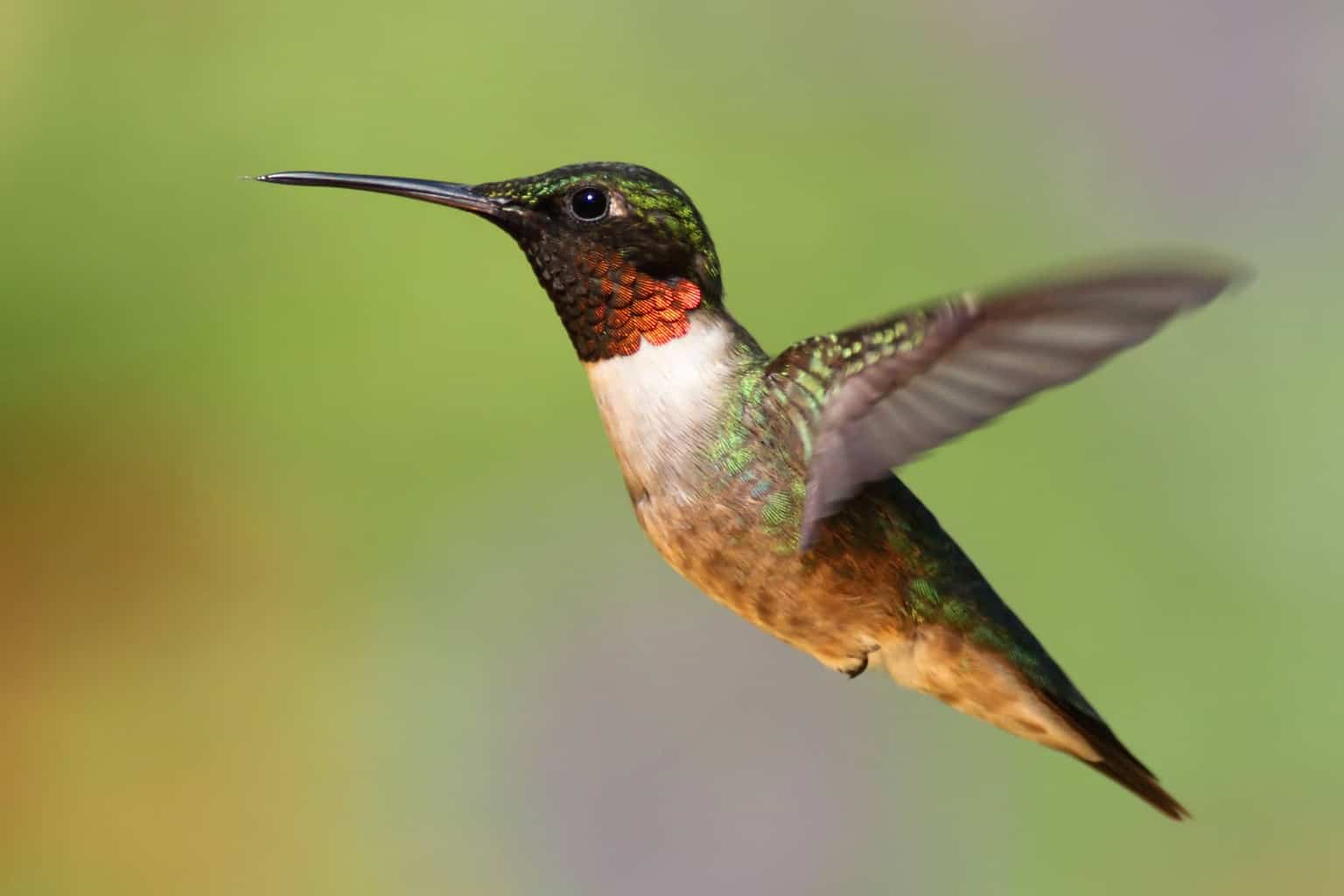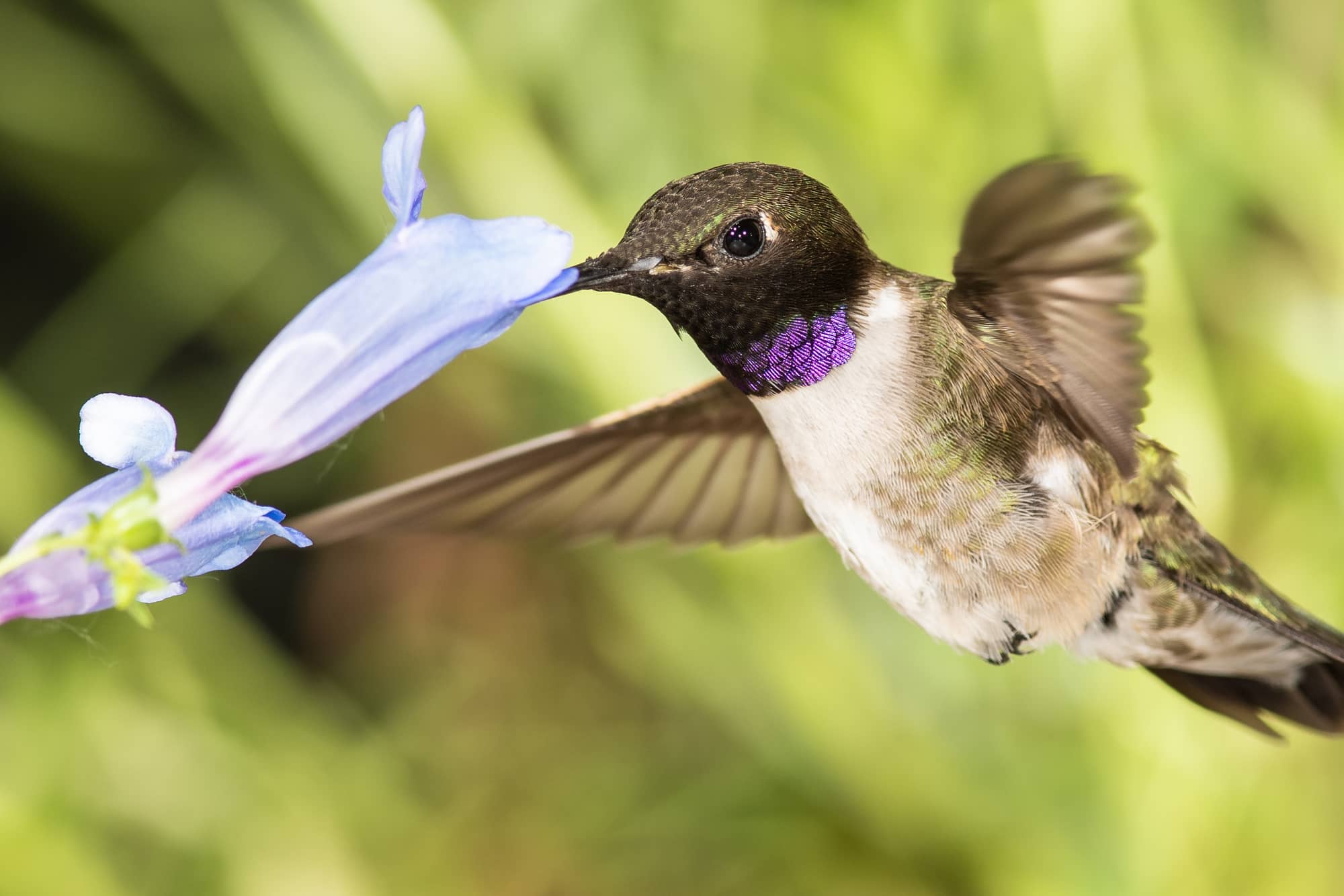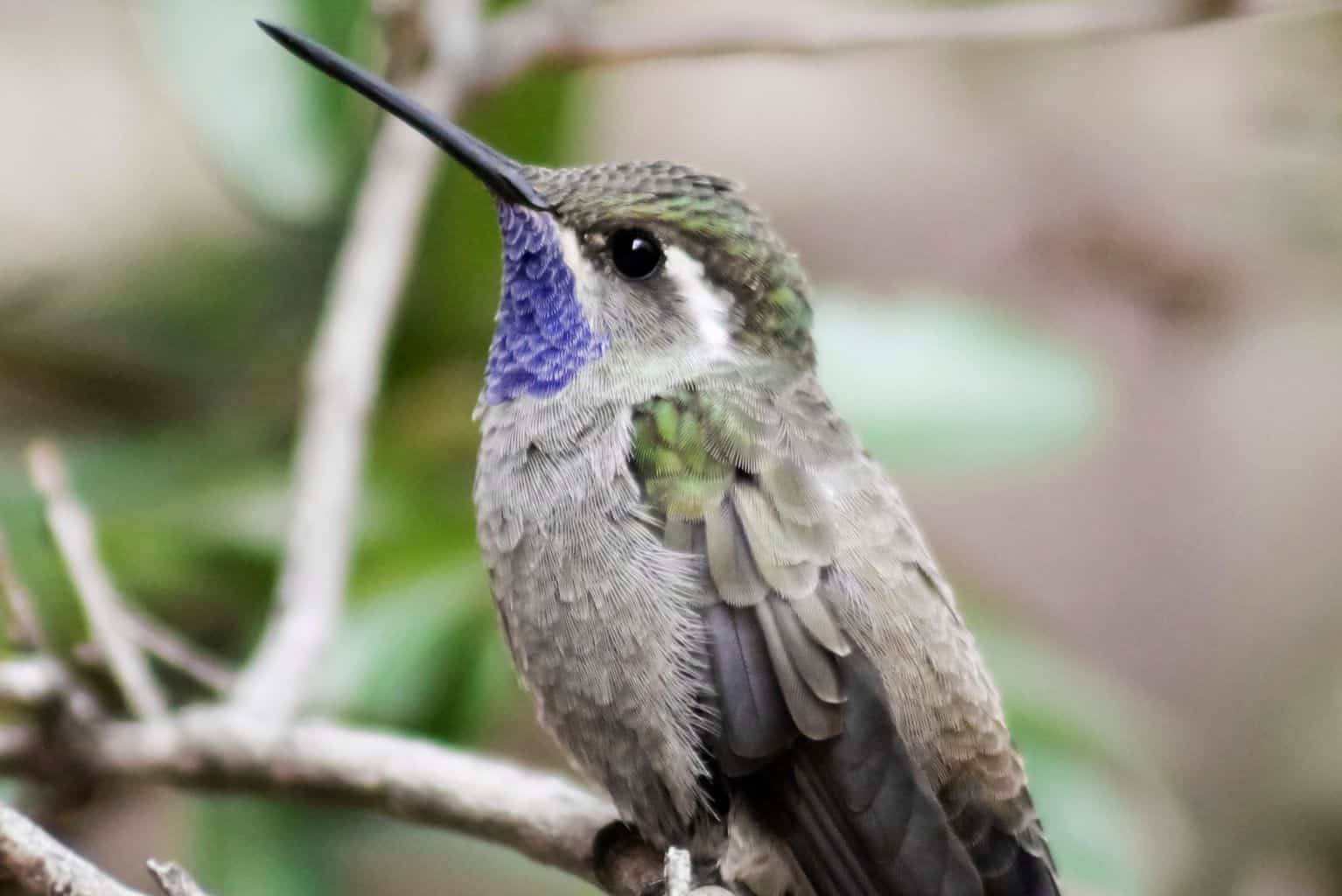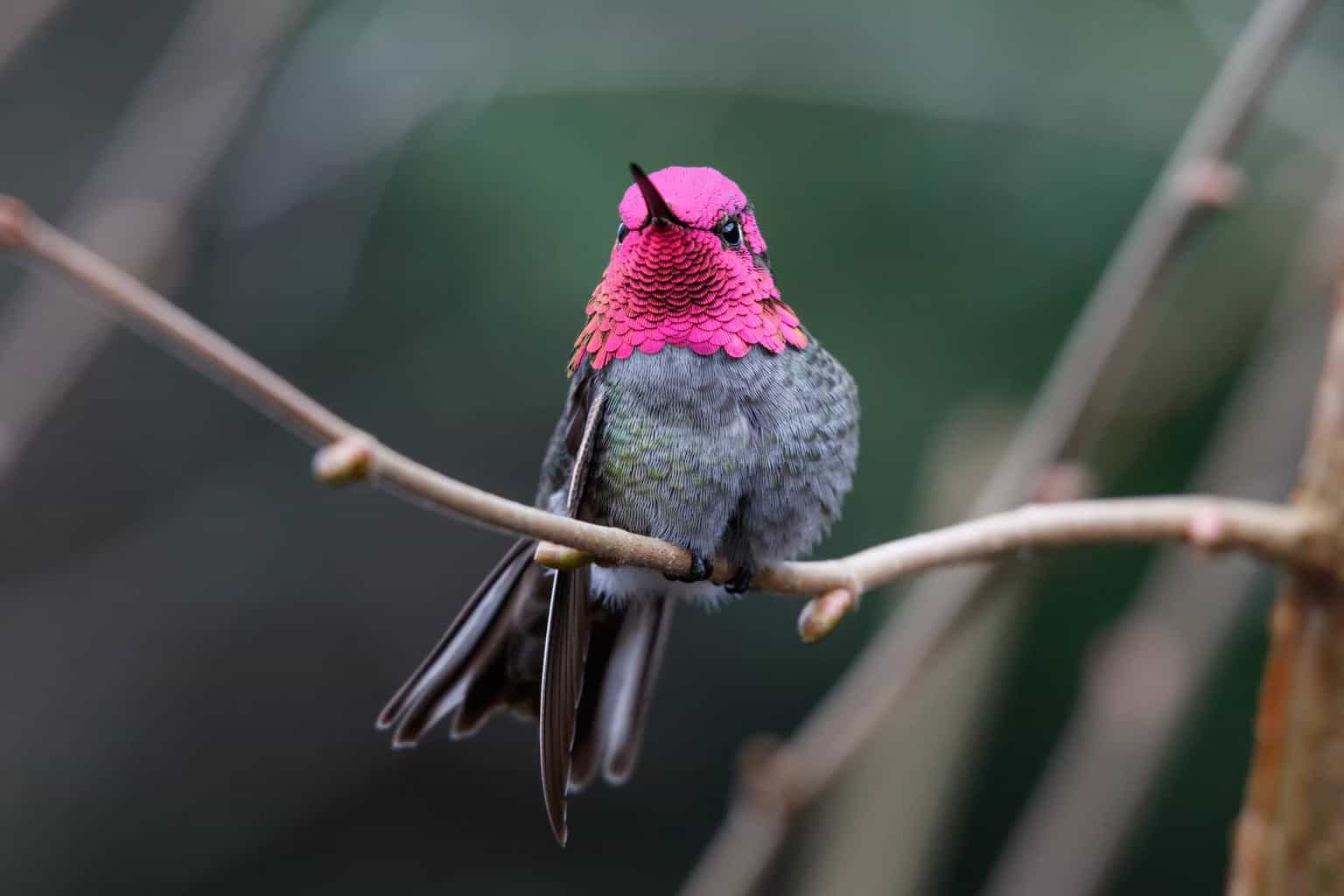The state of Colorado is well known for its breathtaking landscape, wildlife, and variety of fun outdoor activities. Whether you’re out hiking, canoeing, or unwinding in nature, spend some extra time looking for some of the 514 bird species to keep an eye out for, including 12 gorgeous species of hummingbird adding to Colorado’s charm.
Hummingbirds are tiny, eye-catching birds with colorful feathers and personalities capable of hovering in mid-air thanks to their rapidly flapping wings. Additionally, hummingbirds are the only bird species that can fly backward .
Below, you’ll find a list of hummingbird species you can keep an eye out for on your next adventure.
Broad-Tailed Hummingbird (Selasphorus Platycercus)

- Length: 4 inches
- Weight: 3.6 grams
- Wingspan: 25 inches
Description:
Broad-tailed hummingbird males are easily identified by their iridescent, rosy-red gorget, white breast, and metallic green-gray flanks.
Female hummingbirds lack the males’ flashy gorget, and instead display a white, plain throat, similar green-gray flanks, and buff, rufous coloring on their tails.
Additional Information:
Broad-tailed hummingbirds are native breeders that arrive during their spring migration around mid-April to breed in high-elevation meadows, shrubby habitats, and evergreen, pine-oak forests in the western United States.
Broad-tailed hummingbirds primarily feed on flower nectar from brightly coloured flower species or on nectar from plants such as shrubs, trees, and epiphytes. They favor red and tubular-shaped blooms with high sugar contents.
Broad-tailed hummingbirds aggressively protect areas containing plants that are a rich nectar source.
Consider planting vibrant tubular flowers or placing hummingbird feeders to get a closer look at the Broad-tailed hummingbird.
Ruby-Throated Hummingbird (Archilochus Colubris)

- Length: 2.8 to 3.5 inches
- Weight: 3.4 grams for males and 3.8 for females
- Wingspan: 3.1 to 4.3 inches
Description:
Ruby-throated hummingbirds have solid black chins and bills with green-gray flanks. Strikingly similar to the Broad-tailed hummingbird, the male Ruby-throated hummingbirds have brilliant ruby-red gorgets. However, the Ruby-throated hummingbird’s throat patch has a more prominent orange undertone.
The female Ruby-throated hummingbird has a plain gorget with faint dusky streaks and distinctive forked tail feathers.
Additional Information:
Ruby-throated hummingbirds are a common species that typically breed in the eastern United States and winter in Central America. However, rare vagrant sightings can occur during migratory seasons.
Ruby-throated hummingbirds primarily feed on nectar from brightly colored, scented flowers of shrubs, trees, and epiphytes as their primary food source, but they will also eat small insects and spiders.
Due to their petite dispositions, Ruby-throated hummingbirds are vulnerable to insect-eating birds and predatory animals. Additionally, large birds like red-tailed hawks and loggerhead shrikes are a threat to Ruby-throated hummingbirds.
Furthermore, Ruby-throated hummingbirds heavily depend on specific forest plants for food, breeding, and roosting. Due to agricultural growth and clear-cutting of forests, they rapidly lose their natural habitat, posing a significant threat to their survival.
Rufous Hummingbird (Selasphorus Rufus)

- Length: 2.5 inches
- Weight: 2 to 5 grams
- Wingspan: 4.3 inches
Description:
Male Rufous hummingbirds have a white upper breast and rufous crown, flanks, and tail (hence the name) with iridescent copper-red gorgets. Additionally, some males of this common hummingbird species can have a greenish wash on their heads and backs.
Female Rufous hummingbirds tend to be slightly larger than the males with a green head and back and a white, speckled throat with a central orange splotch. Lastly, females showcase dark wings and tail feathers with white tips and a rufous base.
Additional Information:
Known for their defensive and aggressive nature, Rufous hummingbirds produce a variety of high-pitched, chipping, and chattering vocalizations as part of their threat display in addition to aerial displays to ward off threats.
Rufous hummingbirds have the longest migration route of all hummingbirds in the United States. They travel over 2,000 miles from Alaska to Mexico and back during the migration period!
These little fellas feed on sweet nectar from tubular plants using their extendable tongues to reach the nectar. Entice these whimsical birds by planting nectar-rich plants in your yard.
Consider reading Backyard Bird Gardens for more information.
Black-Chinned Hummingbird (Archilochus Alexandri)

- Length: 3.25 inches
- Weight: 2.8 to 3.4 grams
- Wingspan: 4 to 5 inches
Description:
Male Black-chinned hummingbirds typically have gray-green feathers on their heads, backs, and flanks, and distinctive black chins with a white spot right behind their eye. Additionally, black-chinned hummingbirds have iridescent feathers forming a purple band and a contrasting white collar around the bottom of their throat to decorate the black chin and throat.
The female Black-chinned hummingbird has similar markings, including the distinctive black chin; however, females can have faint green streaks on their white throats.
Additional Information:
Black-chinned hummingbirds do not sing. Instead, their call notes are rapidly repeated low tups or raspy chatters (especially when they are territorial and aggressive).
You will often find Black-chinned hummingbirds in mountain meadows, mountain canyons, parks, and as frequent garden visitors.
You can plant vibrant, tubular flowers to attract these beauties or set out hummingbird nectar feeders with sugar water.
Tip: Purchase or create a red hummingbird feeder to improve your chances of attracting one of these tiny hummingbirds.
Blue-Throated Mountain Gem Hummingbirds (Lampornis Clemenciae)

- Length: 4.5 to 4.8 inches
- Weight: 6 to 10 grams
- Wingspan: 3.1 inches for males and 2.3 inches for females
Description:
The Blue-throated Mountain Gem hummingbird is one of the larger hummingbirds, named after the male’s iridescent blue gorget.
The Blue-throated Mountain Gem’s upper plumage is a dull green hue, fading to a medium gray on the underside with a blueish-green belly. The Blue-throated Mountain Gem also has white stripes behind its eyes and a narrower line extending backward from the corner sides of its short bill, bordering a blackish-gray cheek patch.
Additional Information:
Blue-throated Mountain Gems spend winter among the mountain life in the woodlands of Mexico and the highlands as far south as Oaxaca. For their breeding season, they migrate to the canyons of the southwestern United States.
However, vagrants occasionally roam around Colorado in oak forests and various open areas.
Although Blue-throated Mountain Gems are sizable, rapid fliers, they have the slowest wings beat of all North American hummingbird species.
To get a better look at these highly active fellas, invest in a perched hummingbird feeder with sugar water or a birdbath and fountain for the hummingbird to sip water.
Anna’s Hummingbird (Calypte Anna)

- Length: 3.9 to 4.3 inches
- Weight: 2.8 to 5.7 grams
- Wingspan: 4.7 inches
Description:
The males have glossy, iridescent magenta throat feathers, and a neck that can appear black or reddish-orange depending on the lighting. Additionally, the chest, abdomen, and sides of the male Anna’s are gray with a green tint. Lastly, they have a pale, broken eye-ring and the wings and tail are a dusky black-brown.
Females Anna’s, however, have a greener crown, green body, and white-tipped tail, with a pale gray chest and white or red spotting on the gorget.
Additional Information:
Anna’s hummingbirds are well-known for their territorial behavior, making elaborate dive displays to ward off other birds.
Anna’s hummingbirds are among the most prominent and most vocal hummingbirds in the United States. Anna’s hummingbirds are one of few species that produce a song with a series of scratchy noises that sound like sharp metallic “chip” vocalizations.
Did you know that Anna’s hummingbirds can shake their little bodies up to 55 times per second to shed rain while they are in flight?
Anna’s hummingbirds are common year-round in backyards and parks in Colorado Springs, feeding on flowering plants and flying insects. Due to Anna’s hummingbirds’ carnivorous diets, birders need to avoid using insect traps, pesticides, or insecticides that would minimize their insect food source.
Broad-Billed Hummingbird (Cynanthus Latirostris)

- Length: 3.1 to 3.9 inches
- Weight: 3 to 4 grams
- Wingspan: 5.1 inches
Description:
The Broad-billed hummingbird has a long, bright red bill with a black tip.
The male birds are metallic dark green with a blue throat and white under tail coverts. In comparison, females are generally less colorful with a pale belly and white eye stripes over each eye.
Additional Information:
The Broad-billed hummingbird is a summer visitor or vagrant migrator in Colorado.
Both male and female Broad-billed hummingbirds are prone to being chatty, producing chatter sounds that sound like a swift “chi-dit.”
The Broad-billed hummingbird prefers locations with dense vegetations, streamside groves, and open oak woodlands in lower canyons.
They favor flowers with high sugar content and aggressively protect those nectar-rich areas by using aerial flights and fascinating intimidating displays. Although hummingbird feeders are fun and convenient, flowers provide more nutrients than sugar-water feeders, and they effortlessly spruce up your landscape.
Mexican Violetear (Colibri Thelassinus)

- Length: 3.8 to 4.7 inches
- Weight: 4.8 to 5.6 grams
- Wingspan: 4.7 inches
Description:
Mexican violetears have overall emerald green plumage, bluish-green tails, and dark violet cheeks and breasts.
Additional Information:
The Mexican violetear is a medium-sized hummingbird common in forested areas of Mexico to Nicaragua. It is, however, somewhat nomadic and moves around mountainous ranges, meaning that some of these wanderers can reach Colorado.
Mexican violetears are fairly vocal, and sing a jerky, metallic, chipping melody from exposed twigs in their territory.
Mexican violetears belong to the Apodiformes order, meaning “without foot.” While Mexican violetears do have feet, they are petite and relatively weak, meaning that many birds in this order are rarely able to walk.
The Mexican violetear typically forages alone, feeding at mid-level canopies in deforested areas. However, these territorial birds sometimes gather at flowering trees, especially coffee-shade Inga.
Costa’s Hummingbird (Calypte Costae)

- Length: 3 to 3.5 inches
- Weight: 3.05 grams for males and 3.22 grams
- Wingspan: 4.7 inches
Description:
Males have vibrant purple crowns and gorgets with greenbacks and flanks. Their elongated throat feathers flare down their throats, giving the birds a “mustache” appearance.
On the contrary, females have greyish-green crowns and backs with white underbellies and buffy-colored flanks.
Additional Information:
Costa’s hummingbirds are native or seasonal migrants of Colorado with a pretty similar appearance to Anna’s hummingbirds.
Costa’s hummingbirds are typical in dry and scrub or woodland habitats with plant life such as desert scrub, cactus, wolfberry, and most commonly, the Joshua tree. Costa’s hummingbirds’ source a method of pollination for desert plants and cacti.
Costa’s hummingbirds get their name from a French hummingbird expert named Jules Bourcier. Bourcier named the bird after his dear friend, Louis Marie Pantaleon Costa de Beauregard, fond of collecting hummingbirds.
Rivoli’s Hummingbird (Eugenes Fulgens)

- Length: 4.3 to 5.5 inches
- Weight: 7 to 8 grams
- Wingspan: 7.1 inches
Description:
You can identify Rivoli’s Hummingbirds by their large size; however, they have long, straight to slightly curved bills and both sexes appear dark until the sun catches the iridescence of their plumage to flash the brilliant hues.
Adult males are a metallic green-bronze color around their throats and backs with a black chest and purple crown. The females have less bright plumage with a solid gray chest and olive-green back and head.
Additional Information:
Rivoli’s Hummingbirds are the second largest hummingbirds found in Colorado. However, they fall slightly short after the Blue-throated Mountaingem hummingbird.
Rivoli’s Hummingbirds occur in the mountainous areas of southwestern United Stated to Honduras.
Rivoli’s Hummingbirds are generally very friendly and stay close to the garden with their feeding habits.
Add the following plants to your Colorado garden to attract Rivoli’s Hummingbirds
- Bee balm
- Garden Phlox
- Lobelia
- Catmint
- Honeysuckle
Calliope Hummingbird (Stellula calliope)

- Length: 2.8 to 3.9 inches
- Weight: 2 to 3 grams
- Wingspan: 4.3 inches
Description:
Calliope hummingbirds have glossy green upper plumage and creamy white under plumage with relatively short beaks and tails.
Adult Calliope males have a white throat with elongated iridescent wine-red gorget feathers that show a “whiskered” effect when erected. He also has green flanks and a dark tail. In comparison, the adult Calliope females tend to showcase a dull whitish gorget with dark streaks; a pinkish was on their sides and a dark tail with white tips.
Additional Information:
Calliope hummingbirds are the smallest breeding birds found in the United States. Calliope hummingbirds are native or seasonal migrants to Colorado’s high mountain regions.
Calliope hummingbirds are migratory birds that typically have their breeding grounds earlier than most other species to take advantage of the late-summer wildflowers in western North America.
Calliope hummingbirds are the smallest-bodied long-distance migrants worldwide.
The male Calliope hummingbirds claim and vigorously defend their nesting territory while breeding, but they are generally well on their way to Mexico before the young hatch.
White-Eared Hummingbird (Basilinna Leucotis)

- Length: 3.5 to 3.9 inches
- Weight: 3 to 4 grams
- Wingspan: 4 to 5 inches
Description:
White-eared hummingbirds are predominantly green on their backs and breasts, with white bronze-green tails and a distinctive white eyestripe marking on their blackhead.
White-eared hummingbirds have a red, black-tipped beak. The males have a metallic turquoise-green gorget with violet patches on their faces. Females tend to be duller than male White-eared hummingbirds.
Additional Information:
White-eared hummingbirds are vagrant or accidental species in Colorado that are very rarely seen.
White-eared hummingbirds generally range from Nicaragua to the mountainous regions in southeastern Arizona and southwestern New Mexico. White-eared hummingbirds’ breeding habits are pine-oak forests from southeastern Arizona, southwestern New Mexico, and western Texas.
Although rare in Colorado, you can attract White-eared hummingbirds just like other hummingbirds. Plant vibrant, nectar-rich flowers or use a hummingbird feeder to encourage visits.
Conclusion
To date, there are recorded sightings of twelve different hummingbird species in Colorado.
Most of these species are, unfortunately, accidental visitors making them a rare sight. The four most common hummingbirds you’ll find in Colorado are the Broad-tailed hummingbird, Rufous hummingbird, Calliope hummingbird, and Black-chinned hummingbird.
Colorado is rich in wildlife; if you’re interested in a few impressive bird species native to Colorado, read our following post covering Birds In Colorado: Unique And Interesting Species.

